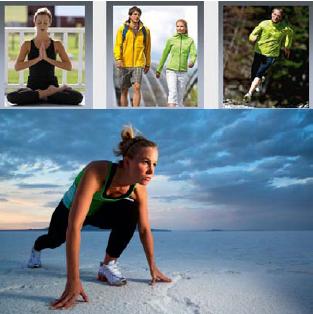 The pleasant, warm temperatures attract all types of sports people to go outside. Cyclists, joggers, hikers and inline-skaters all spend their leisure time in the open air. Therefore it is important to choose the right clothing.
The pleasant, warm temperatures attract all types of sports people to go outside. Cyclists, joggers, hikers and inline-skaters all spend their leisure time in the open air. Therefore it is important to choose the right clothing.
Sportswear must incorporate many properties so that the sportsperson does not overheat during movement, but also does not cool down during rest periods. Another difficulty in the cooler transition period is that several layers have to be worn on top of each other. These must be attuned to each other so that each individual item of clothing can fulfil its own specific function.
Sportspeople demand a great deal from modern sports textiles which must keep the body warm whilst at the same time divert sweat away from the body. The specialist "Function and Care" department at the Hohenstein Institute in Bönnigheim investigates and optimises the different properties. The different degrees of sweating (vaporous sweat and liquid sweat) can be simulated by using what is known as the Skin Model.
This model enables the sweat management of sportswear to be established through the use of different parameters. These tests are particularly important for sportswear, since in order to provide the best possible support for the sports person, clothing must divert sweat away from the body, since moisture makes skin sensitive and more prone to injuries such as blisters.
Sweating does have one big benefit to sports people in summer as through evaporation during sport, sweat cools the body and prevents it from overheating. Ideally sweat evaporates on the skin and cools it directly. However when practising sport in summer a film of sweat nearly always forms on the skin.
Therefore large quantities of liquid sweat must be diverted away from the body so that evaporation cooling can occur. Then the sweat film which forms on the skin must immediately be cooled before the skin can benefit from it. If liquid sweat is diverted away from the skin, the sweat can then evaporate directly on the skin and then cool effectively. On the other hand sweat transported away from the skin evaporates further away and cools less.
Scientific studies have shown how dependent a person is on the comfort of his or her clothing. For example, scratchy or sweat-impermeable materials are not only unpleasant; they also reduce the performance of the wearer. However,it it is not only performance sports people who rely on heat-physiologically optimised clothing, leisure sports people also take advantage of the achievements of modern textiles.
Optimum cuts and the combination of different textiles ensure that the clothing meets the requirements. For instance, in areas of the body where there is a tendency to sweat more, materials are used which are particularly effective in diverting sweat away from the body.
Other areas are protected from cooling down through heat-insulating fabrics. Sportswear should dry as quickly as possible so that the wearer does not cool down further after the end of the sports activity.
The skin sensorial properties of the materials are also considered. The clothing must feel pleasant against the skin. It must not scratch, cause abrasions or stick to the moist skin. Sports textiles should increasingly be both comfortable and provide active support to the sports person.



